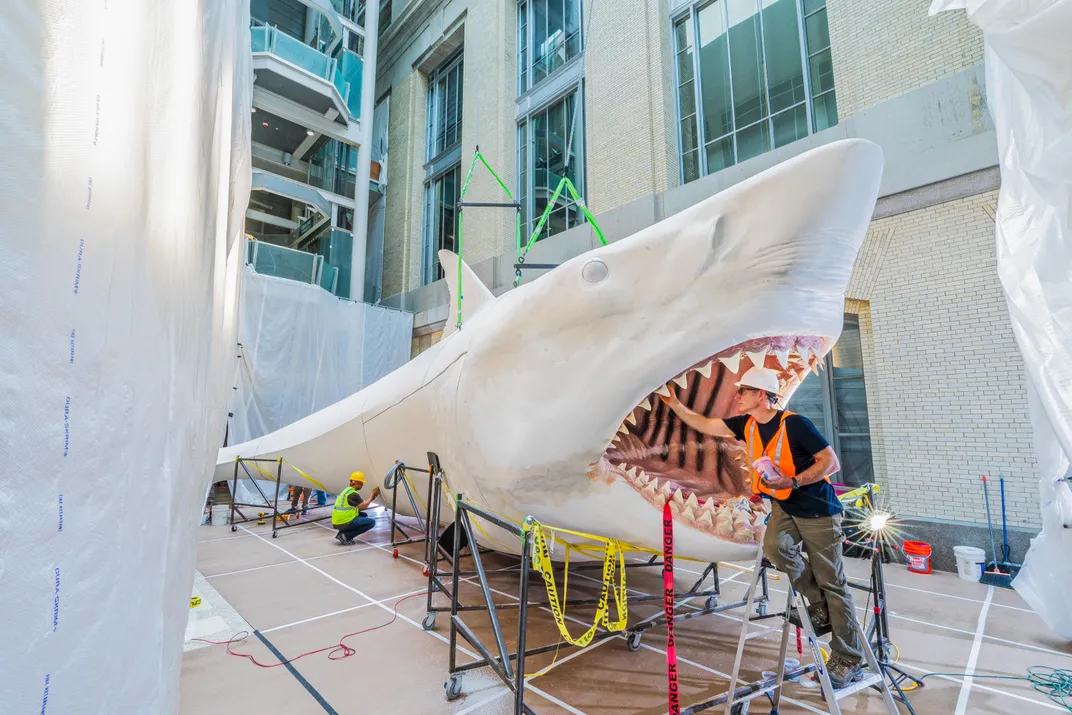Reimagining the Megalodon, the World’s Most Terrifying Sea Creature
The ancient beast of the oceans comes to life in a new display at the National Museum of Natural History
:focal(934x872:935x873)/https://tf-cmsv2-smithsonianmag-media.s3.amazonaws.com/filer/df/14/df14c47c-a08e-4062-8453-951a32b8aa9d/jun2019_d23_prologue.jpg)
When I reached the world’s pre-eminent sculptor of long-dead monsters, he was standing atop a ladder inside a 16-foot-tall section of a megalodon tail that was propped upright in his warehouse-size studio. “I’m sorry if it sounds like I’m inside a bathroom,” Gary Staab said on his cellphone. The tail was part of a 52-foot-long, life-size model of the prehistoric shark that Staab was custom-building for the Smithsonian’s National Museum of Natural History.
The mighty megalodon, terror of the ancient oceans, could grow to 60 feet long, with a mouth stretching more than 9 feet wide and a bite-force stronger than any other creature ever, living or dead. The violent damage it caused to its prey, and the rows of serrated teeth, have given the shark the reputation of an enormous prehistoric Jaws—“a great white on steroids,” says Hans Sues, chair of paleobiology at the museum.
In fact, Sues says, evidence suggests that megalodons, which lived between 23 million and 3.6 million years ago, were more closely related to modern mako sharks than to great whites, giving them more slender bodies than great whites and a bronzy back befitting a predator that preferred coastal waters.
Plentiful megalodon teeth (and a number of calcified vertebrae) have been found in ancient seafloors that are now exposed—in the cliffs along the Chesapeake Bay, for example. Those fossils were all Staab was going to get: Like modern sharks, the megalodon’s skeleton was made from cartilage, which decomposes. So to design the model, he and his museum collaborators used a formula that extrapolates from tooth length and the body geometry of modern relatives, and found that his shark would be 24 feet across the front fins. “That’s the size of a Cessna,” he told me.
To bring the shark to life, Staab then hand-sculpted a detailed, six-foot-long clay model, laser-scanned the sculpture and milled 386 foam pieces that, when assembled, became a full-scale prototype (the foam itself being too flammable for museum display). Next he fabricated 21 fiberglass panels on top of that, with interior ribs that aligned and bolted together.
In April, the model was broken down and trucked from Staab’s studio in Kearney, Missouri, to Washington, D.C. On the museum floor, Staab reassembled the behemoth from the inside before crawling out a section in the tail. The shark was touched up with epoxy and fresh paint and raised 85 feet in the air to hang, menacingly, above museum visitors dining in a new café.
“My job is to not have a style,” he said, “but rather to be the animal—to make that thing as believable as possible.”

The National Museum of Natural History opens its new Hall of Fossils—Deep Time exhibition on June 8, 2019.